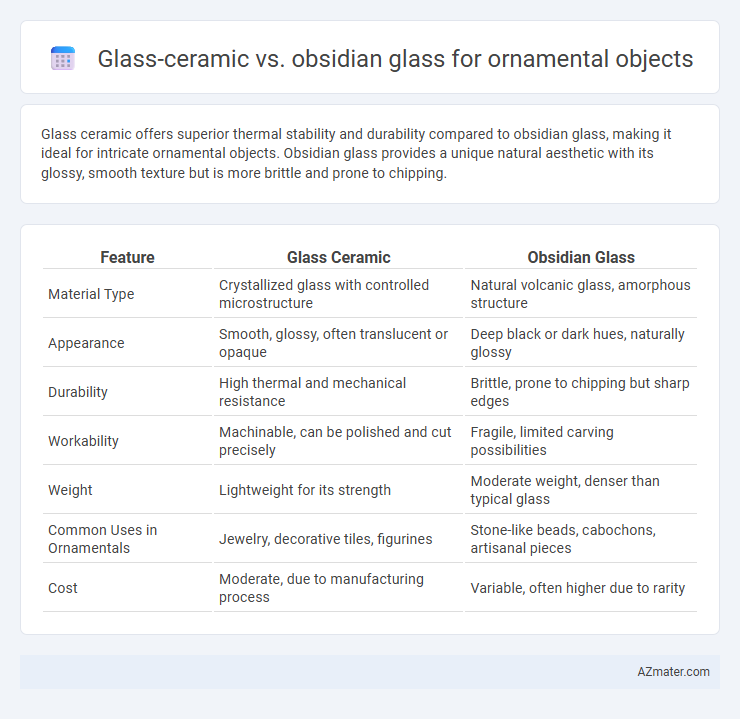Glass ceramic offers superior thermal stability and durability compared to obsidian glass, making it ideal for intricate ornamental objects. Obsidian glass provides a unique natural aesthetic with its glossy, smooth texture but is more brittle and prone to chipping.
Table of Comparison
| Feature | Glass Ceramic | Obsidian Glass |
|---|---|---|
| Material Type | Crystallized glass with controlled microstructure | Natural volcanic glass, amorphous structure |
| Appearance | Smooth, glossy, often translucent or opaque | Deep black or dark hues, naturally glossy |
| Durability | High thermal and mechanical resistance | Brittle, prone to chipping but sharp edges |
| Workability | Machinable, can be polished and cut precisely | Fragile, limited carving possibilities |
| Weight | Lightweight for its strength | Moderate weight, denser than typical glass |
| Common Uses in Ornamentals | Jewelry, decorative tiles, figurines | Stone-like beads, cabochons, artisanal pieces |
| Cost | Moderate, due to manufacturing process | Variable, often higher due to rarity |
Introduction to Glass Ceramic and Obsidian Glass
Glass ceramic features a unique microstructure combining glassy and crystalline phases, resulting in superior thermal stability, mechanical strength, and translucency ideal for ornamental objects. Obsidian glass, a naturally occurring volcanic glass, is prized for its sharp edges and glossy, deep black appearance, making it a historically significant material for decorative and functional artifacts. Both materials offer distinctive aesthetic qualities, with glass ceramic providing customizable opacity and coloration, while obsidian delivers a natural, lustrous finish.
Composition and Manufacturing Process
Glass ceramic used for ornamental objects is composed primarily of silica combined with controlled crystallization agents such as lithium, aluminum, and magnesium oxides, which enhance durability and thermal stability through a precise heat treatment process. Obsidian glass, on the other hand, is a naturally occurring volcanic glass primarily composed of silica with trace elements like iron and magnesium, formed by rapid cooling of felsic lava without crystal growth. Manufacturing glass ceramic involves a two-step process of melting raw materials followed by nucleation and crystallization heat treatments, while obsidian is naturally formed and minimally processed for ornamental use, preserving its vitreous texture and sharp fracture patterns.
Visual Aesthetics and Color Variations
Glass ceramic offers exceptional visual aesthetics with its smooth, glossy finish and ability to showcase subtle color gradients, enhancing ornamental objects with a sophisticated and modern appeal. Obsidian glass provides deep, rich black hues with natural, reflective surfaces that create dramatic, striking contrasts ideal for bold decorative pieces. The color variations in glass ceramic range from translucent to opaque pastels, while obsidian glass primarily delivers intense, uniform darkness with occasional natural inclusions adding unique textural interest.
Durability and Scratch Resistance
Glass ceramic offers superior durability and scratch resistance compared to obsidian glass, making it ideal for ornamental objects that require long-lasting beauty and minimal maintenance. Its crystalline structure enhances hardness and thermal stability, reducing the risk of chips and scratches during handling. Obsidian glass, while aesthetically striking with its natural volcanic appearance, is more prone to scratching and chipping due to its amorphous, less resilient composition.
Texture and Surface Finish
Glass ceramic offers a smooth, polished surface with a consistent texture that enhances ornamental objects through its glossy, reflective finish. In contrast, obsidian glass exhibits a natural, slightly rough texture with a deep, vitreous luster that provides a more organic and unique surface appearance. The choice between the two depends on whether the ornamental design emphasizes uniform elegance or raw, natural beauty.
Light Transmission and Reflectivity
Glass ceramic exhibits lower light transmission but higher reflectivity due to its crystalline microstructure, making it ideal for ornamental objects emphasizing reflective elegance. Obsidian glass offers higher light transmission with a smooth, natural surface that enhances translucency and depth in decorative pieces. The choice between these materials affects visual impact, with glass ceramic providing a glossy, reflective finish and obsidian creating a luminous, semi-transparent appearance.
Design Flexibility and Shaping Techniques
Glass ceramic offers superior design flexibility for ornamental objects due to its ability to withstand high temperatures and thermal shock, enabling intricate shapes and detailed textures through various shaping techniques like molding, cutting, and etching. Obsidian glass, being naturally formed volcanic glass, is more brittle and less adaptable to extensive shaping, limiting design options primarily to carving and polishing. The controlled crystallinity in glass ceramics allows for a wider range of aesthetic finishes and structural forms compared to the more fragile and opaque nature of obsidian glass.
Maintenance and Cleaning Requirements
Glass ceramic ornamental objects require minimal maintenance due to their high resistance to scratches and thermal shock, making them easy to clean with mild detergents and a soft cloth. Obsidian glass, although visually striking, is more fragile and prone to chipping, necessitating careful handling and gentle cleaning methods, such as using lukewarm water and non-abrasive sponges to avoid surface damage. Both materials benefit from regular dusting, but glass ceramic offers greater durability and ease of upkeep for long-term ornamental display.
Cost Comparison and Market Availability
Glass ceramic offers a cost-effective solution for ornamental objects, generally priced lower than obsidian glass due to its synthetic production and widespread manufacturing processes. Obsidian glass, a natural volcanic material, tends to be more expensive and less consistently available, contributing to higher market prices and limited supply. Market availability favors glass ceramic as it is produced at scale with stable distribution channels, while obsidian glass remains niche, impacting both cost and accessibility for ornamental applications.
Best Applications for Ornamental Objects
Glass ceramic offers exceptional durability and thermal stability, making it ideal for intricate ornamental objects exposed to temperature variations or mechanical stress. Obsidian glass, prized for its natural volcanic origin and deep glossy finish, excels in decorative pieces where aesthetic richness and uniqueness are paramount. For ornamental applications demanding both strength and artistic appeal, glass ceramic provides functional longevity, while obsidian glass delivers distinct visual elegance.

Infographic: Glass ceramic vs Obsidian glass for Ornamental object
 azmater.com
azmater.com